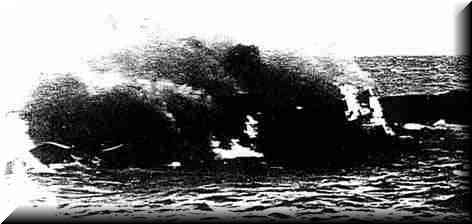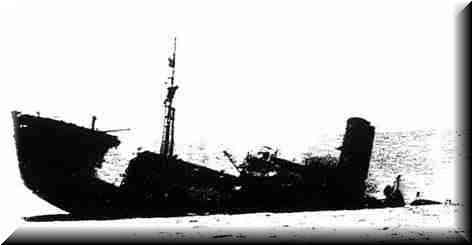|
Marauders of the Sea, German Armed Merchant Ships During W.W. 2
Thor, Second Cruise Thor ( Ship 10) Second Cruise A secondary intention was to draw off Naval ships needed to fight the Battle of the Atlantic, thus using up precious oil, ships, their crews, to search vast tracts of the ocean, seeking out these will-of-the~wisp Raiders , to bring them to battle and destroy them. Both "Atlantis" and "Kormoran" had been sunk in November 1941, and not one German Raider was on station for the first time since March of the previous year. (18) To change that situation, by the end of November 1941, "Thor," had been prepared to make her second foray as a Raider, and she left Kiel under Captain Gumprich who had replaced Kahler. By stages "Thor" crept down the European coastline to arrive at Gironde on the 17th. of December. Under cover of the prevailing bad weather, "Thor" left this port on the 14th. of January 1942. The continuing bad weather forced this Raider to run for shelter at the Southern end of the Bay of Biscay, then they headed Southward into the Atlantic, until reaching the Antartic Circle. Using air reconnaissance proved abortive, not an enemy vessel of any kind any where to be found. "Thor" was seeking out the whaling fleets, she now retraced her steps Northwards, and, in the vicinity of Capetown, on the 13th of March, was sighted by the old British Cruiser 'Durban." The challenge brought a response from the Raider, that she was the British freighter 'Levernbank," thus satisfied, "Durban" proceeded on her way. On the following day, the A.M.C. "Cheshire" also challenged "Thor" who blandly replied that she was a British ship - again the bluff worked, and the Raider again got away with it! Eventually, these two episodes when reported, brought forth an enquiry from the British Admiralty which showed that neither Warship had any way of really finding out that "Thor" was not the vessel she claimed to be. These obvious blunders sparked attempts at tightening up the challenge and reply system to ensure phoneys were unmasked. "Thor," on her way to meet a replenishment ship, the 'Regensburg' sighted funnel smoke on the horizon. It was the 23rd. of March, the smoke emanated from the 3,942 ton Greek "Pagasitikos," a torpedo sent her to the bottom, and 32 men and one woman were taken aboard the Raider. In many cases during the war it was flinnel smoke that gave away the whereabouts of a merchant ship to an enemy Raider or hostile Warship, a ship producing smoke was frowned on by the Commodore of a convoy. it put the whole convoy at risk by drawing attention to them, and if a ship was on its own, smoke would bring down the Captain's wrath upon the engine room watchkeepers. The same rules applied to Warships, smoke free conditions, allowed suprise to be maintained. For old coal burning ships, it was a most difficult task to proceed at any speed without producing a telltale swirl of smoke from their flinnels, but try, to remain smokeless, was the constant aim of all ships' engine room personnel. The following day replenishment was achieved, and the ocean was combed for targets, on the 28th. of March masts were sighted,but after a 3 hour chase it needed to be abandoned as "Thor" was too slow to catch her potential victim. In another 2 days her seaplane found the British ship "Wellpark," which "Thor" had to pursue for 7 hours before stopping her with gunfire. The sea plane had also attacked this ship but was driven off by accurate AA defence. The ship was abandoned and scuttled, "Thor" continued her search.
 British ship "Wellpark" (19) The new Captain made much better use of his Aircraft than did all other Raider Captains, and on the 1st. of April he sank by torpedo, the "Willesden," of 4,563 tons, which had also been sighted by his seaplane. In another 2 days, the Norwegian "Aust," of 5,630 tons, also spotted by the seaplane, was shelled, then abandoned, and demolition charges saved the use of shells or torpedoes. On this cruise, "Thor" was the first Raider to be fitted with Radar. This new weapon flushed out a ship, out of sight to the naked eye, she was followed all day, and on nightfall, at the close range of 1,700 yards was fired upon, this immediately stopped this ship which proved to be the "Kirkpool." A torpedo completed this action and the 32 crew were rescued from the ocean
 British ship "Kirkpool" All this recent activity had taken place in the South Atlantic, close to the Cape of Good Hope, and very much in the shipping lane, with Capetown the focus for many ships either inward bound for Britain or outbound to the Gulf area to avoid the Mediterranean, or to India, Ceylon, or to Australia and New Zealand. "Thor" was now ordered by SKL to shift his search to the Indian Ocean, and was warned to watch out for Japanese Submarines and their areas of operation. By the 10th. of May they were about 1,500 miles off the Western Australian coastline when their seaplane sighted the 'Nankin," a liner of 7,131 tons. The aircraft in a daring pass over the ship managed to snatch away the radio aerial, preventing any distress signal being sent off. A prize crew was placed on board, and they departed to meet up with "Regensburg," both these ships then made for a Japanese port. The Radar installation continued to provide much frustration, with a good deal of down time, but on the 16th. of June, it did come good, producing an excellent contact, at 10,000 yards. By using a converging course "Thor" arrived within 1,800 yards of this ship, which was seen to be a Tanker. Her steering gear was put out of action with the first German salvo, and the Dutch "Olivia" blazed away totally on fire, many of her crew dying on board or in the burning water covered with oil. "Thor" appears to have had gun crews that on many occasions used their weapons with accuracy, achieving a large number of hits on enemy ships, and often striking their foe with their first salvo, no doubt a lot of training went into preparing gun crews for action, but I have yet to uncover any reports on this aspect of the Raiders' operations. However, it was essential for any Raider to quickly subdue an enemy ship, before the alarm could be raised bringin~ the opposing forces quickly to the scene, thus good gunnery paid its dividend hy ensuring survival for the Raider. A survivor gave useful information to his captors that allowed "Thor" to capture 2 Norwegian Tankers - the 'Herborg," 7,892 tons on the 19th. of June, and on the 4th. of July, the 'Madrona," - of 5,894 tons. Both these ships were sailed off to Japan with prize crews. Four survivors from the "Olivia" made the long and arduous journey to Madagascar in an open boat. (20) On the 2Oth. of July, a long gunnery battle between "Thor," and the British freighter "Indus" took place, half of the British crew were killed in this action, and "Thor's" company also suffered casualities. In six months of operation, this Raider had sunk 10 ships totalling 56,037 tons, she now made her way up to Yokohama in Japan for a long refit. It was here that "Thor" met the Tanker "Uckermark," which had formerly been the "Altmark," and had featured in the "Cossack" incident in February 1940, in Jossingijord. It was in "AItmark" that 299 prisoners, taken by the "Graf Spee" were held captive. She was stormed by a boarding party from "Cossack" and her prisoners released with that famous cry" The Navy is here" "Thor" and "Uckermark" lay alongside each other in a basin at Yokohama, and an official luncheon was held for both Japanese and German news people on the 30th. of November. Just before 1400 (2PM) there was a loud detonation on board the "Uckermark." This was quickly followed by a more intense explosion. Huge flames leapt from the Tanker, and soon both ships were ablaze. A third explosion removed "Uckermark's" bridge, and damaged the "Thor's" upperworks. Both ships began to sink, and their crews rushed ashore, or leapt overboard into the waters of the basin, the former "Nankin," now renamed "Leuthen" also caught alight, as the whole basin was now covered with burning oil. It was 2200 (10PM) before the flames died down. The 3 German ships plus a Japanese ship also trapped in this basin were no more, the deadly oil fire had done its task, all 4 ships totally lost. 43 from "Uckermark" and a further 13 from "Thor" perished in this disaster. The cause of this debacle seems to have been a spark in the fume laden air within the fuel tanks of "Uckermark" setting off the initial detonation, probably as a result of repairs being executed by a work gang. An ignominous end to a Raider that had caused the death of 2l ships, had survived 3 encounters with larger British Armed Merchant Cruisers. "Thor" had been cut down by an accident, when the might of the Royal Navy had failed to destroy her. next chapter |
